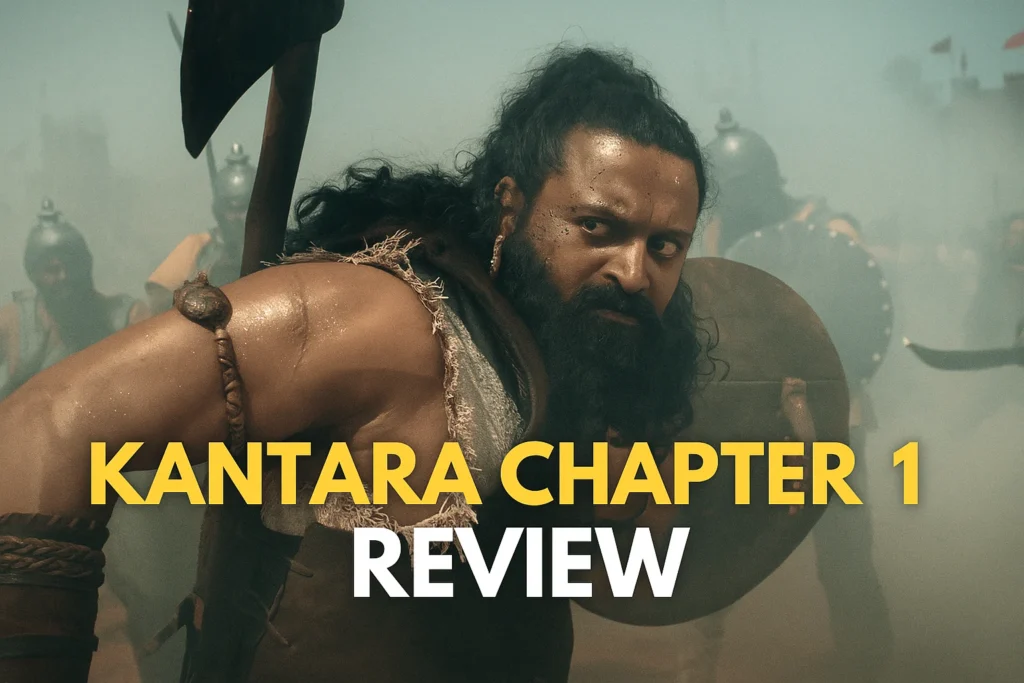
Kantara Chapter 1 delivers a visually rich and emotionally charged cinematic experience, acting as a rousing prequel to the original blockbuster by Rishab Shetty. The film meticulously merges breathtaking visuals, myth, and powerful storytelling, making it a noteworthy addition to modern Indian cinema.
Grand Visuals That Captivate
One of the greatest strengths of Kantara Chapter 1 lies in its visuals. Director Rishab Shetty, along with cinematographer Arvind Kashyap, crafts a world that is both lush and mysterious. The forests of pre-colonial coastal Karnataka brim with life and symbolism, housing the tribal communities who guard their spiritual secrets fiercely. This cinematic landscape is not just a backdrop; it is a character in itself, drawing viewers into a world where nature and divinity are deeply fused. Every frame feels carefully constructed, offering a visual spectacle rare in Indian period dramas.
Powerful Performances and Unfolding Myth
Rishab Shetty headlines Kantara Chapter 1 as Berme, delivering a complex portrayal vastly different from his earlier role as Shiva in the original film. Berme is both a mortal and a conduit for the divine, torn between earthly struggles and mythic obligations. Rukmini Vasanth stands out with her poised performance as Princess Kanakavathi, bringing surprising nuance and strength to her character. Gulshan Devaiah menaces as King Kulashekara, while Jayaram embodies nobility and weariness as the aging royal.
Supporting characters are not reduced to mere archetypes. Their humanity and conflicts are woven into the story, whether it’s in moments of comic relief or in the brewing storms of rivalry and revenge within the royal and tribal worlds.
Thematic Depth and Folk Rituals
Kantara Chapter 1 thoughtfully explores deep-rooted themes: resistance, oppression, nature worship, and the uneasy truce between faith and power. The film’s spiritual pulse beats strongest in the depiction of folk rituals like Bhuta Kola and Kumbhabhishekam. These rituals aren’t mere visual flourishes—they are central to the narrative’s emotional and metaphysical stakes, linking the fate of mortals to capricious deities.
Music, Sound, and the Legend’s Heartbeat
B. Ajaneesh Loknath’s background score emerges as one of Kantara Chapter 1’s most potent storytelling elements. The score uplifts the drama, deepening the immersion and ensuring that even scenes with sparse dialogue resonate with emotional weight. Mythical chants and atmospheric sound design accentuate the film’s magical realism, connecting the folklore to contemporary themes.
Strengths and Shortcomings
Kantara Chapter 1 earns praise for its ambitious scope and technical finesse. Its greatest achievement remains the immersive myth-making and the attempt to expand the cinematic universe of Kantara. Yet, some critics argue that the screenplay doesn’t always match the complexity or emotional punch of the original film, occasionally slipping into predictability or losing narrative momentum in pursuit of grandeur.
Final Verdict
Despite minor flaws, Kantara Chapter 1 establishes itself as a visually stunning and culturally resonant saga. For those seeking an epic steeped in mythology and driven by stellar performances, Rishab Shetty’s Kantara Chapter 1 is a must-watch and cements the director as a formidable storyteller in contemporary Indian cinema. Using Kantara Chapter 1 as a keyword: Kantara Chapter 1 is not just a prequel—it is a cinematic celebration of folklore, faith, and legacy.
Read Other Blog Posts- Click Here
- Thanksgiving 2025 – Celebrating Togetherness & Blessings
- Tata Motors Demerger Commercial Vehicles Business – Share Listed
- Bihar Elections Exit Polls 2025: Trends, Predictions & Implications
- SEBI Warning Sparks Concern: Is Your Digital Gold Investment Safe?
- Groww IPO Day 3 Live: ₹6,632 Crore Issue Closes Today — Check Price Band, GMP, Allotment Date, Valuation & More
